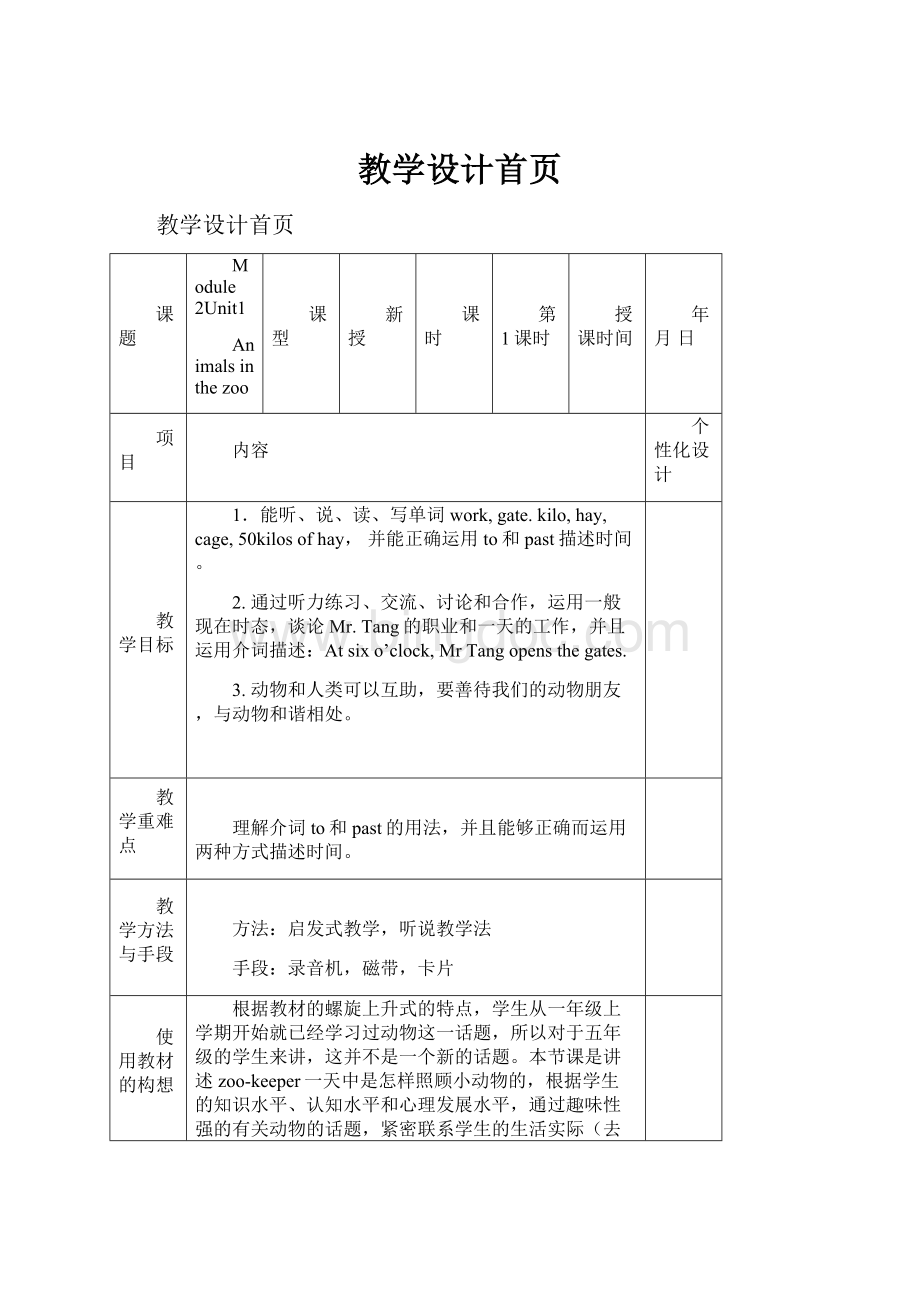教学设计首页.docx
《教学设计首页.docx》由会员分享,可在线阅读,更多相关《教学设计首页.docx(32页珍藏版)》请在冰点文库上搜索。

教学设计首页
教学设计首页
课题
Module2Unit1
Animalsinthezoo
课型
新授
课时
第1课时
授课时间
年月日
项目
内容
个性化设计
教学目标
1.能听、说、读、写单词work,gate.kilo,hay,cage,50kilosofhay,并能正确运用to和past描述时间。
2.通过听力练习、交流、讨论和合作,运用一般现在时态,谈论Mr.Tang的职业和一天的工作,并且运用介词描述:
Atsixo’clock,MrTangopensthegates.
3.动物和人类可以互助,要善待我们的动物朋友,与动物和谐相处。
教学重难点
理解介词to和past的用法,并且能够正确而运用两种方式描述时间。
教学方法与手段
方法:
启发式教学,听说教学法
手段:
录音机,磁带,卡片
使用教材的构想
根据教材的螺旋上升式的特点,学生从一年级上学期开始就已经学习过动物这一话题,所以对于五年级的学生来讲,这并不是一个新的话题。
本节课是讲述zoo-keeper一天中是怎样照顾小动物的,根据学生的知识水平、认知水平和心理发展水平,通过趣味性强的有关动物的话题,紧密联系学生的生活实际(去动物园的看动物的体验),激发学生学习动物类单词和话题的学习动机。
板书设计
Unit1Animalsinthezoo
教学设计续页
教学流程
个性化设计
调控
一、Pre-taskpreparation:
1.Reviewknownanimalvocabulary
(showthepictures)Pointtoeachofthepicturesofanimalsandinvitedifferentstudentstonametheanimals.
2.(showthepictureofaman)
T:
Who’she?
S:
He’sazoo-keeper.
T:
Yes,he’sMrTang.He’sazoo-keeper.Heworksinazoo.
3.Readthewords:
workworks
二、While-taskprocedure:
1.T:
WhatdoesMrTangdoinazoo?
Listentothetape.
2.Listenagainandrepeat.
3.(hangasmallblackboard)Readthetimetableandlearnthewords:
gate,cage,kilos,50kilosofhay.
4.AskquestionsaboutthetimewhenMrTangdoesthingsinthezoo.
e.g.T:
WhattimedoesMrTangopenthegates?
S:
Heopensthegatesatsixo’clock.
(payattentiontotheword:
opens)
5.Learnthetime:
twentytonine.
6.Askquestionsaboutthefood.
e.g.T:
WhatdoesMrTangeat?
S:
Heeatsnoodlesandchicken.
T:
Whatdothetigerseat?
S:
Theyeatmeat.
T:
Howmuch?
S:
10kilosoffruit.
7.Workinginpairs,thestudentsaskandanswertheotherquestionsofanimals.
三、Post-taskactivity.
UsingthecompletedtaskandthetimetableonPage22oftheStudent’sBookinvitedifferentstudentstotalkaboutwhatMrTangdoesinthemorningatthezoo.
e.g.:
MrTangisazoo-keeper.Heworksinazoo.ThencanyoutellwhenMrTangopenthegatesandcleanthecages?
S:
Atsixo’clock,MrTangopensthegates.Athalfpastsix,hecleansthecages.
一上课就让学生见到活泼可爱的动物,增加了课堂气氛,同时又为下面作了充分准备。
用问题引出将要听的内容一是给学生听的要求,二是帮助学生更好地理解内容,为学生学习提供良好的氛围。
当堂达标设计
Exercisesofworkbook.
作业设计
练习
1.Talkaboutyourdailylifewithyourdeskmate.
2.Writesomesentencesaboutzoo-keeper’sdailylife.
预习
PreviewthewordsandtextonP4
教学反思
现象与归因分析
改进措施
教学设计首页
课题
Module2Unit1
Animalsinthezoo
课型
新授
课时
第2课时
授课时间
年月日
项目
内容
个性化设计
教学目标
1.通过交流、讨论、合作、阅读理解,找到课本中问题的答案。
2.在完成学习任务的过程中,熟练运用特殊疑问句。
e.g.Howmuchhaydotheyeat?
/Whatdotheelephantseat?
/Whattimedoyoufeedtheelephants?
3.引导学生了解动物和培养学生热爱动物的情感态度。
教学重难点
正确运用特殊疑问句,并回答。
教学方法与手段
方法:
启发式教学,情景教学法
手段:
录音机,磁带,卡片,幻灯片
使用教材的构想
对教材内容进行适当的补充。
在巩固练习部分,运用特殊疑问句提问更多关于动物的疑问句。
使课堂内容更贴近学生的生活。
E.g.Whattimedoyoufeedyourcat?
板书设计
Unit1Animalsinthezoo
教学设计续页
教学流程
个性化设计
调控
Pre-taskpreparation:
1.Review:
feed—feedsopen—opens
eat—eatshave—has
clean—cleanswork—works
2.Dailytalk:
T:
Whattimedoyougetup?
Whattimedoeshegetup?
Whendoyoueatyourbreakfast?
Whendoesheeathisbreakfast?
3.Saysomethingaboutazoo-keeper.
e.g.S:
I’mazoo-keeper.Iworkinazoo.Ifeedtheanimals.Atsixo’clock,Iopenthegates.Athalfpastsix,Icleanthecages.Iliketheanimals.
1.Asksomequestionsaboutthezoo-keeper.
e.g.Whattimedoyouopenthegates?
While-taskprocedure:
1.Lookatthetimetable(P22)
T:
Whatdothetigerseat?
S:
Theyeatmeat.
T:
Howmuchmeatdotheyeat?
S:
Theyeat10kilosofmeat.
Writedownthesentences:
Howmuchmeatdotheyeat?
Theyeat10kilosofmeat.
2.Workinginpairs.
3.(showsomepictures)
T:
Look,thisisMrTang.He’sazoo-keeper.
ThisisBenandkitty.TheyaskMrTangSomequestions.
4.Listentothetapeandrepeat.
5.Listenagainthenlookattheirbooksandreadthesentences.
6.Actoutthisdialogue.
Post-taskactivities:
1.LookattheslideofP23.(Askandanswer)
T:
WhattimedoesMrTangfeedthemonkeys?
S:
Hefeedsthemateighto’clock.
T:
Whatdothemonkeyseat?
S:
Theyeatfruit.
T:
Howmuchfruitdotheyeat?
S:
Theyeat10kilosoffruit.
2.Theteacherfillsintheblanks.
Workinginpairs,thestudentsaskandanswersimilarquestionstocompletetheothertwocards.
复习动词在单三人称的句型中的用法,同时归纳动词+s的用法,为后面的课文学习铺垫。
通过谈话自然引出主题,为学生的语言输出提供了良好的氛围。
反复操练what…和how…引导的疑问句
学生声情并茂的分角色扮演课文,有助于理解和记忆课文。
看图复习,有效的提高可课堂效率。
当堂达标设计
Dopart2AskandanswerofPage21
作业设计
练习
1.Readthedialogue
2.Makeadialogueaccordingtothetext.
预习
PreviewthewordsandtextonP22
教学反思
现象与归因分析
改进措施
教学设计首页
课题
Module2Unit1
Animalsinthezoo
课型
新授
课时
第3课时
授课时间
年月日
项目
内容
个性化设计
教学目标
1.能听、说、读、写单词left,right,up,down.并能运用goto,goup,walkalong…的句子为他人指路。
2.通过看地图、交流、讨论和合作,体验、实践,运用祈使句为他人指路。
3.培养学生热心帮助人的习惯。
教学重难点
正确运用goto,goup,walkalong…的句子为他人指路。
教学方法与手段
方法:
启发式教学,听说教学法,
手段:
录音机,磁带,两张地图,一张幻灯片
使用教材的构想
适当补充教材内容。
运用两张地图,请学生在创设的情境中,运用所学句型为他人指路。
板书设计
Unit1Animalsinthezoo
教学设计续页
教学流程
个性化设计
调控
Pre-taskpreparation:
1.Listentoasong“Penguin’sgame”
2.T:
Whichworddoyouhear?
S:
Left,right.
3.Learnthewords:
left,right
4.Thestudentsstandup,andthendotheactions.
5.Onestudentsaysthewords,theothersdotheactions.
6.Theteacherdoestheactions,thensaytothestudents“down,up”
7.Learnthewords;thentheboyssaythewords“down,up”andthegirlsdotheactions.
8.Learn:
along.Drawapictureontheboardandsaythemeaning.
9.Readthefivewords.
10.Saytherhyme
Left,leftright,rightup,downandalong
Left,leftright,rightgoupandgodown.
While-taskprocedure:
1.(hangthemap)T:
Look,thisisGongnongRoad.YougotoGongnongRoad.Myschoolisontheright.
2.Learnthephrases:
ontherightontheleft
3.T:
Where’sthesupermarket?
Isitontheright?
S:
It’sontheleft.
T:
Youcansay“GotoGongnongRoad.Thesupermarketisontheleft.
4.Workinginpairs.
5.(hanganothermap)T:
ThisisRenminRoad.Ifyoudon’tknowhowtogettothebank,hospital.Pleaseaskyourdeskmate.
6.Inviteagrouptoactouttheplay.
7.T:
Where’sDongfangCinema?
Howdoyougettothecinema?
S:
…
T:
GotoRenminRoad.WalkalongRenminRoad.Crossaroad.Thecinemaisontheright.
8.Learnthephrases:
walkalong,crosstheroad.
9.Sayagain,thestudentsrepeat.
10.Encouragethestudentstosaythem.
11.Lookattheslide(P24)
Readthewords:
YananRoad,RainbowHotel,HolidayHotel,MoonPark,tourist.
12.Listentothetapeandrepeat.
13.Workinginpairs,asonestudentisgivingthedirections,theotherstudentistracinginpenciltheroutetoMoonPark.
Post-taskactivities:
1.Thestudentsaskandanswerquestionaboutplacesonthemap.
2.Nowlistening:
(1)ListentothetapetwiceandtraceMouseKiki’sdirectionsinpencilonthemapandtomarkwherethecheeseis.
(2)Showthestudent’smap.
节奏欢快的歌曲让学生身心愉快,很快进入学习状态。
把单词编成儿歌,使学生在轻松的气氛中复习巩固新授词汇,加深学生的理解和记忆。
。
通过设计贴近学生真实生活的情景,在对话中培养学生语言的综合运用能力。
边听边画图,充分体现了培养学生创造和想象思维能力的原则。
当堂达标设计
DotheWorkbook5B
作业设计
练习
1.Displaythestreetplanoftheareanearyourschoolandsayaboutyourschool.
2.Drawaparrot.(standing,flying,sitting,eating,ortalking)
预习
PreviewthewordsandtextonP24
教学反思
现象与归因分析
改进措施
教学设计首页
课题
Module2Unit1
Animalsinthezoo
课型
新授
课时
第4课时
授课时间
年月日
项目
内容
个性化设计
教学目标
1.能听、说、读、写单词branch,正确运用形容词描述鹦鹉。
2.通过看图片、交流、讨论和合作、实践,正确运用句型Godownthesteps./Walkupthesteps.为他人指路。
3.培养学生热爱动物的情感态度。
教学重难点
正确运用句型Godownthesteps./Walkupthesteps.为他人指路。
教学方法与手段
方法:
启发式教学,体验式教学
手段:
录音机,磁带,卡片,两张幻灯片
使用教材的构想
适当补充教材内容,在对话的基础上让学生用Therebe句型描述。
板书设计
Unit1Animalsinthezoo
教学设计续页
教学流程
个性化设计
调控
Pre-taskpreparation:
1.Saytherhyme:
Left,leftright,rightup,downandalongLeft,leftright,rightgoupandgodown.
2.Lookattheslide(P24).Workinginpairs,thestudentstaketurnstoaskandanswerquestionsaboutthemap.
e.g.S:
WhereistheHolidayHotel?
S:
GoalongYananRoad.TheHolidayHotelisontheright.
3.Lookattheslide(P25)
T:
Wherearetheelephants?
S:
GotoZooRoad.Theelephantsareontheleft.
4.T:
Ifyouarehere.Yougodownthesteps.Crosstheroad.Walkupthesteps.Theelephantsareontheleft.
5.Learnthesentences:
Godownthesteps.Walkupthesteps.
6.Workinginpairs,thestudentsaskandanswertheparrotsorbirds.
7.Listentothetapeandrepeat.
8.Thestudentsreadthedialogue.
While-taskprocedure:
1.Thestudentstakeouttheirparrots.
2.Practicethedialogue
e.g.:
T:
Lookatmyparrot.It’sredandblue.
S:
Whatisitdoing?
T:
It’sstanding.
3.Workinginpairs.
4.(hangapictureofabigtree).There’saparrotonthebranch.
5.T:
Look,there’saparrotonthebranch.(Thenthestudentsreadtheword:
branch.)
6.Putthestudents’parrotsonthepicturethenaskandanswer.
e.g.:
S1:
Where’stheredandyellowparrot?
S2:
It’sonthebranch.
Post-taskactivity:
Invitedifferentstudentstopointtoaparrotontheparrotfriezeanddescribeit,statingitscolouranditslocation.
e.g.Theyellowandredparrotisunderthetree.
提供学生说的机会,让学生的个性得以充分发展。
通过操练让学生把刚学的知识马上运用,激发了学生学习的欲望。
在对话的基础上让学生用陈述句表达,扩充了本节课的内容。
当堂达标设计
Dothepart2ofP24:
Listenandcircle
作业设计
练习
1.Lookatyourparrot,saysomethingaboutit.
2.Lookatyourtown’smap;makeadialogueaccordingtothedialogue.
预习
PreviewthewordsandtextM3
教学反思
现象与归因分析
改进措施
教学设计首页
课题
Module2Unit2
Favouritetoys
课型
新授
课时
第一课时
授课时间
年月日
项目
内容
个性化设计
教学目标
1.能听